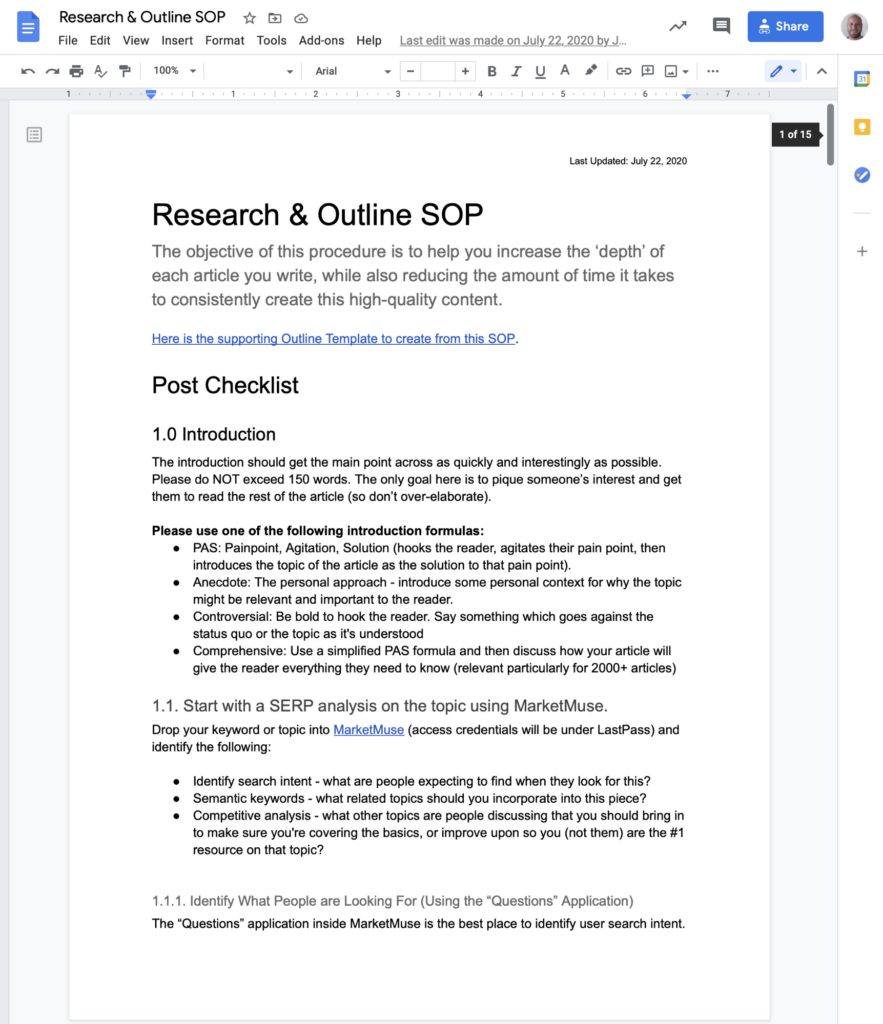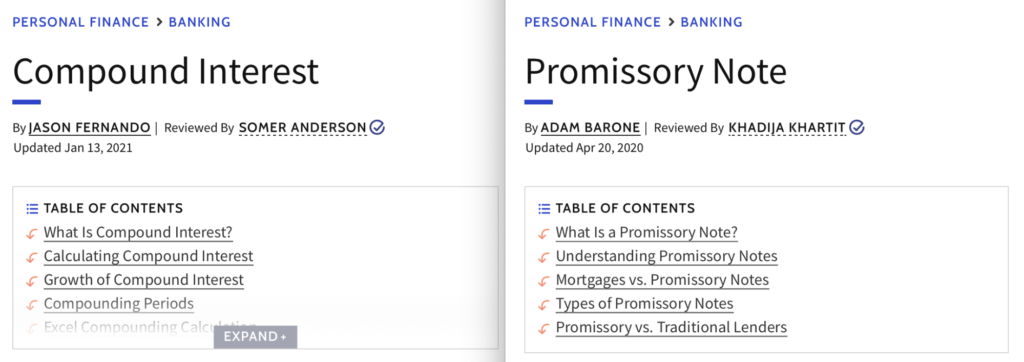
Sure. It’s true.
A content outline is like the backbone of any article, blog post, novel, or essay.
But it’s so much more than that.
Asked how Michelangelo carved the iconic David, he replied that the sculpture was already there – he just needed to get rid of the waste around it.
Fast, efficient, painless writing is exactly the same. It stems from already knowing exactly what you’re going to be writing about, and how all the tricks and turns will flow together.
And the secret to that level of military-like preparation isn’t so secret after all.
Content outlines help you plan how your unique angle on a topic will stand out, provide the context for why anyone should actually read it, and build enough depth into each section so that the final product is compelling (as opposed to generic).
In this article, I’ll show you exactly how to put together content outlines that will actually Make Writing Fun Again.
Effortlessly export your Google Docs to WordPress with just 1-click.
Get Started Today
Show me a writer that writes without an outline, and I’ll show you an inconsistent amateur – not the stone cold professional that helps companies sell more products, or lands book deals, or gets published across huge magazines, or simply helps you succinctly answer an exam.
That’s right. You don’t. Or at least, you can’t. Not very well.
And that’s the problem.
Any complex writing (~a few thousand words and up) requires depth and breadth and flow. It needs to inform one second, before entertaining the next, while also persuading and engaging people to make them care (enough to finish reading, anyway).
Doing that is hard. The longer the piece, the harder it gets.
Lacking any one ingredient makes it that much harder for your writing to do what it’s meant to do – not just entertain you for a few hours while writing, but impacting your readers life in some way, shape, or form.
Business writing needs to create action. It could be a simple follow-up to a click to an opt-in or purchase.
Fiction writing needs to transport someone to another dimension and move them to feel what each character is feeling.
While journalism should (but often doesn’t) change people’s perspectives on tricky or taboo subjects.
None of that is easy. Especially as would-be readers turn into the Zombie Apocalypse all around us, getting sucked into Facebook or YouTube or god forbid, whatever the hell happens over on TikTok.
The point is that the actual writing and accomplishing all of these feats it the hard part. Working off a content outline makes that seemingly-impossible feat a tiny bit more probable.
It gives you the space and time take your research, factor in your content planning, and build off of your content briefs to make sure you’re fully prepared.
Remember:
Fast, effortless writing doesn’t always mean you’re a good writer. It means you’re the most prepared writer.
And anyone who needs to make a living from typing on their keyword knows that the best way safeguard your mental sanity is to focus on fast, effortless writing… by being extremely prepared… with detailed outlines before you ever even start.
Look.
I give up.
I’ve already exhausted all I know about fiction writing. And it wasn’t much to begin to be fair.
So I’m laying down my arms, there. 🏳️
BUT, I do know a little something about writing for businesses. About content marketing at the highest level. About content writing for some of the best business sites on the ‘net, as well as the biggest brands in tech. And scaling out a team of a few dozen writers to produce website content for the Internet’s 1%.
So no, I can’t help you order an outline for your next novel. My competency there falls short.
However, I can help you figure out how to consistently prep content outlines for companies tos scale your own writing operation or make more than a full-time living from it directly.
My company currently works with something like ~45 writers, producing over ~300 articles/month for tons of different sites. That’s easily thousands of articles for the past few years.
And I’m going to show you how we train writers to properly prep content outlines.
Now, we don’t have time to delve into each part of our 15-page process. But we can cover the Cliff Notes version to give you the gist.

High level, there are only three parts of an outline you need to worry about:
Easy, right? You can adapt this to simple 500-word ideas to ~10,000-word guides.
As always, the devil is in the details though. So here’s a quick peek at each of those three parts.
There’s an old saying in journalism: don’t bury the lede. (Which is just a douchey, pretentious way of saying “lead,” or the main point of your piece.)
However…
Online, we want to slightly break the rules a bit.
Yes, you do want to state the main topic + angle right up front. People need to know what they’re in for, and what your unique point of view on this subject is interesting enough to keep reading.
BUT, we then we want to add a few unique sections.
SERP Analysis: What is the search intent, and what topics you’ll cover?
Search Engine Result Pages (SERPs) help you understand the search intent, or question that are asking and wanting to read when they type something into Google.
We delve deep here in our content optimization piece, but the quick backstory is that you want to structure your content subheadings around the common questions or sub-topics based on actual research.

SERP Questions (“People Also Ask” & “related searches”)
Often, you can find this “research” by simply going over to Google, typing in the topic you’re about to write on, and then looking at what is already showing up. “People also ask” questions, for instance, tell you exactly what people are already wondering.

Otherwise, you can and should research the actual content already ranking to see how they’re structure, what they’re talking about, and what they’re potentially leaving out so that you can jump in to fill the gap.
There are lots of complex, techy ways to do this (that are beyond the scope of this article – check out our free course for more). But the easiest way is to simply go read what’s already out there, making notes on what you think is or isn’t most relevant.

Summarize compelling hook
Last but not least: what’s the compelling reason people should:
Think of each section of content as its own little story. If you’d write a catchy opening line for the introduction of your piece… you should also write a catchy opening line for the introduction of each section.
So each one should have it’s own little sub-narrative that flows from one point to another, answering whatever is in your subheading, before creating the perfect segue to the next section.
Short blog posts might only have one section (outside of the introduction and conclusion). While in-depth articles might have anywhere from ~three (for ~1-2k-word posts) to 10+ depending on how long you’re going.
But then when you stack all those content areas up on top of each other, they should create a seamless narrative like any traditional story arc.
Overall, most online content should follow the old classic PAS copywriting formula:
Driving straight into the solution, without developing the problem (or agitating it) often means the reader won’t understand the seriousness of their own issue and will be much less likely to take action.
In English, that means they won’t read the full article or click and buy your widget.
Preplanning all these beats in a content outline is the best way to make sure you don’t write something that fails to move readers.
Pro Tip: Writing for businesses requires a little extra effort. Often, that comes into providing better expert sources and evidence to back up your claims.
The best antidote you’ve got, that should 100% be included in any outline prior to writing, includes a mix of:
Weak conclusions can often feel like an afterthought. By this point, both reader and writer are tired and wanting to wrap up ASAP. So it’s often phoned-in or watered down. And it fails to leave the reader with some lasting impact.
That’s why GOOD conclusions are often the difference between action and radio silence.
If you’ve got someone reading this long, you need to make this last opportunity count.
Again, I’ll try to make your life easy with four clear-cut ways to do just that:
Easy peasy.
Now, let’s summarize these main points into a flashy graphic to entertain the visual learners who’ve skimmed down this far already.
Objective: Here’s what we’re looking for (and how we’ll ‘grade’ your outline):
Grandmasters in chess aren’t necessarily smarter than you or me.
Hell, they probably even wouldn’t last a day in our shoes.
But what they DO know, unsurprisingly, is MUCH more about chess than we do.
And when acclaimed people like Anders Erickson studied how experts use Deliberate Practice to acquire new skills, they found a few common threads.
Experts at the top of their game know:
So chess Grandmasters don’t have like supersized brains per se.
Instead, they know more patterns of play, along with how the current pieces on the board should interact over the next dozen moves in the future.
Apply this same concept to writing. A content expert isn’t necessarily a brainiac. But they do understand how all the pieces should fit to create a killer content strategy, along with having greater attention to detail for each section of the content creation process we just went through (along with a more robust vocabulary).
Here’s an real content outline example from our own work to help illustrate this point:

But wait, there’s more!

I won’t say “writer’s block” is a complete myth.
However, I will say that it’s overblown.
The best way to unlock good writing is to actually AVOID sitting down to write in front of a blank white screen.
When the words just aren’t coming, the very last thing in the world you should be doing is starting from scratch.
Instead, take a step back.
Better ideas usually always starts with more research; the painstaking process of identifying new concepts, coming up with unique angles on a topic that’s already been written millions of times before, piecing together critical data points to back up each supporting claim, and finding the compelling examples or evidence that perfectly illustrate your points.
And all of that stuff NEEDS to live in a tightly-prepared content outline.
Because when it does, the words will seamlessly flow from one line to the next, and your fingers won’t stop tapping until they tire after a few hours of effortless writing.